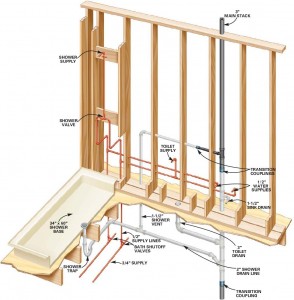Water accesses the house through a main supply pipe that is connected to a water utility main; unless of course you get your water from a well. Typically, a water meter records usage from the water utility. Most new homes have a backflow preventer and a main shutoff valve, typically located near where the water supply pipe joins up with the house. The main shutoff valve is used to control the flow of water going into the home.
Once the water has entered the house, the main supply pipe divides into two branches – one for the cold water and one for the hot water. If a water softener is assembled into the water system, it should be either on the main water supply line before it divides, or on the branch supplying the water heater only.
For most of their length, hot and cold water pipes run side by side together until they reach the proximity of the fixtures and appliances. There, risers connect the fixture or appliance to the water system. Risers are vertical metal or plastic tubes that connect the faucet to the water supply stop valve. Metal Flex Risers are corrugated because they bend easy. Risers are most always hidden inside the walls.
Water supply pipes are installed with a slight angle and they also angle back toward the lowest point so all pipes can be drained through a valve or spout at that point.
Many water using appliances and fixtures have their own shutoff valves. These permit you to shut off the water in order to make repairs without having to cut off the main water supply to the whole house.
HOW TO PREPARE FOR A WATER EMERGENCY
Everyone in the house should learn where all water shutoff valves are – both at the fixtures and at the main shutoff valve.
